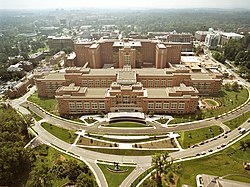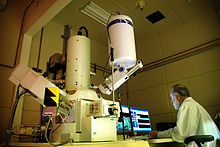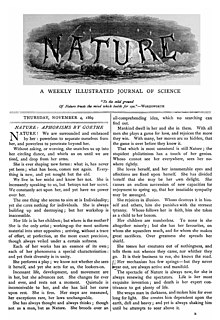
National Institutes of Health logo
| |
 Aerial photo of the NIH Mark O. Hatfield Clinical Research Center, Bethesda, Maryland | |
| Agency overview | |
|---|---|
| Formed | 1887 |
| Preceding agency |
|
| Headquarters | Bethesda, Maryland, U.S. |
| Employees | 20,262 |
| Annual budget | |
| Agency executive |
|
| Parent agency | Department of Health & Human Services |
| Child agencies | |
| Website | www.nih.gov |
The National Institutes of Health (NIH) is the primary agency of the United States government responsible for biomedical and public health research. It was founded in the late 1870s and is now part of the United States Department of Health and Human Services. The majority of NIH facilities are located in Bethesda, Maryland. The NIH conducts its own scientific research through its Intramural Research Program (IRP) and provides major biomedical research funding to non-NIH research facilities through its Extramural Research Program.
As of 2013, the IRP had 1,200 principal investigators and more than 4,000 postdoctoral fellows in basic, translational, and clinical research, being the largest biomedical research institution in the world, while, as of 2003, the extramural arm provided 28% of biomedical research funding spent annually in the U.S., or about US$26.4 billion.
The NIH comprises 27 separate institutes and centers of different biomedical disciplines and is responsible for many scientific accomplishments, including the discovery of fluoride to prevent tooth decay, the use of lithium to manage bipolar disorder, and the creation of vaccines against hepatitis, Haemophilus influenzae (HIB), and human papillomavirus (HPV).
History
The Laboratory of Hygiene in 1887
Ida A. Bengtson, a bacteriologist who in 1916 was the first woman hired to work in the Hygienic Laboratory.
Dedication of first six NIH buildings by President Franklin D. Roosevelt in 1940
NIH campus in Bethesda, Maryland, in 1945
NIH's roots extend back to the Marine Hospital Service
in the late 1790s that provided medical relief to sick and disabled men
in the U.S. Navy. By 1870, a network of marine hospitals had developed
and was placed under the charge of a medical officer within the Bureau
of the Treasury Department. In the late 1870s, Congress allocated funds
to investigate the causes of epidemics like cholera and yellow fever,
and it created the National Board of Health, making medical research an official government initiative.
In 1887, a laboratory for the study of bacteria, the Hygienic Laboratory, was established at the Marine Hospital in New York.
In the early 1900s, Congress began appropriating funds for the Marine
Hospital Service. By 1922, this organization changed its name to Public
Health Services and established a Special Cancer Investigations
laboratory at Harvard Medical School.
This marked the beginning of a partnership with universities. In 1930,
the Hygienic Laboratory was re-designated as the National Institute of
Health by the Ransdell Act,
and was given $750,000 to construct two NIH buildings. Over the next
few decades, Congress would increase funding tremendously to the NIH,
and various institutes and centers within the NIH were created for
specific research programs. In 1944, the Public Health Service Act was approved, and the National Cancer Institute became a division of NIH. In 1948, the name changed from National Institute of Health to National Institutes of Health.
In the 1960s, virologist and cancer researcher Chester M. Southam injected HeLa cancer cells into patients at the Jewish Chronic Disease Hospital.
When three doctors resigned after refusing to inject patients without
their consent, the experiment gained considerable media attention.
The NIH was a major source of funding for Southam's research and had
required all research involving human subjects to obtain their consent
prior to any experimentation.
Upon investigating all of their grantee institutions, the NIH
discovered that the majority of them did not protect the rights of human
subjects. From then on, the NIH has required all grantee institutions
to approve any research proposals involving human experimentation with
review boards.
In 1967, the Division of Regional Medical Programs was created to
administer grants for research for heart disease, cancer, and strokes.
That same year, the NIH director lobbied the White House for increased
federal funding in order to increase research and the speed with which
health benefits could be brought to the people. An advisory committee
was formed to oversee further development of the NIH and its research
programs. By 1971 cancer research was in full force and President Nixon
signed the National Cancer Act,
initiating a National Cancer Program, President's Cancer Panel,
National Cancer Advisory Board, and 15 new research, training, and
demonstration centers.
Funding for the NIH has often been a source of contention in
Congress, serving as a proxy for the political currents of the time. In
1992, the NIH encompassed nearly 1 percent of the federal government's
operating budget and controlled more than 50 percent of all funding for
health research, and 85 percent of all funding for health studies in
universities.
While government funding for research in other disciplines has been
increasing at a rate similar to inflation since the 1970s, research
funding for the NIH nearly tripled through the 1990s and early 2000s,
but has remained relatively stagnant since then.
By the 1990s, the NIH committee focus had shifted to DNA research, and launched the Human Genome Project.
Directors
The NIH Office of the Director
is the central office responsible for setting policy for NIH, and for
planning, managing and coordinating the programs and activities of all
NIH components. The NIH Director plays an active role in shaping the
agency's activities and outlook. The Director is responsible for
providing leadership to the Institutes and Centers by identifying needs
and opportunities, especially in efforts involving multiple Institutes. Within this Office is the Division of Program Coordination, Planning and Strategic Initiatives with 12 divisions including:
- Office of AIDS Research;
- Office of Research on Women's Health;
- Office of Disease Prevention;
- Sexual and Gender Minority Research Office;
- Tribal Heath Research Office;
- Office of Program Evaluation and Performance.
Previous directors:
- Joseph J. Kinyoun, served August 1887 – April 30, 1899
- Milton J. Rosenau, served May 1, 1899 – September 30, 1909
- John F. Anderson, served October 1, 1909 – November 19, 1915
- George W. McCoy, served November 20, 1915 – January 31, 1937
- Lewis R. Thompson, served February 1, 1937 – January 31, 1942
- Rolla Dyer, served February 1, 1942 – September 30, 1950
- William H. Sebrell, Jr, served October 1, 1950 – July 31, 1955
- James Augustine Shannon, served August 1, 1955 – August 31, 1968
- Robert Q. Marston, served September 1, 1968 – January 21, 1973
- Robert Stone, served May 29, 1973 – January 31, 1975
- Donald S. Fredrickson, served July 1, 1975 – June 30, 1981
- James B. Wyngaarden, served April 29, 1982 – July 31, 1989
- Bernadine Healy, served April 9, 1991 – June 30, 1993
- Harold E. Varmus, served November 23, 1993 – December 31, 1999
- Elias A. Zerhouni, served May 2, 2002 – October 31, 2008
- Francis S. Collins, served August 17, 2009
Locations and campuses
Intramural research is primarily conducted at the main campus in Bethesda, Maryland and Rockville, Maryland, and the surrounding communities.
The Bayview Campus in Baltimore, Maryland houses the research programs of the National Institute on Aging, National Institute on Drug Abuse, and National Human Genome Research Institute with nearly 1,000 scientists and support staff. The Frederick National Laboratory in Frederick, MD and the nearby Riverside Research Park, houses many components of the National Cancer Institute,
including the Center for Cancer Research, Office of Scientific
Operations, Management Operations Support Branch, the division of Cancer
Epidemiology and Genetics and the division of Cancer Treatment and
Diagnosis.
The National Institute of Environmental Health Sciences is located in the Research Triangle region of North Carolina.
Other ICs have satellite locations in addition to operations at the main campus. The National Institute of Allergy and Infectious Diseases maintains its Rocky Mountain Labs in Hamilton, Montana, with an emphasis on BSL3 and BSL4 laboratory work. NIDKK operates the Phoenix Epidemiology and Clinical Research Branch in Phoenix, AZ.
Research
Clinical Center – Building 10
As of 2017, 153 scientists receiving financial support from the NIH have been awarded a Nobel Prize and 195 have been awarded a Lasker Award.
Intramural research
NIH
devotes 10% of its funding to research within its own facilities
(intramural research). The institution gives 80% of its funding in research grants
to extramural (outside) researchers. Of this extramural funding, a
certain percentage (2.8% in 2014) must be granted to small businesses
under the SBIR/STTR program. The extramural funding consists of about 50,000 grants to more than 325,000 researchers at more than 3000 institutions. In FY 2010, NIH spent US$10.7bn (not including temporary funding from the American Recovery and Reinvestment Act of 2009) on clinical research, US$7.4bn on genetics-related research, US$6.0bn on prevention research, US$5.8bn on cancer, and US$5.7bn on biotechnology.
Public Access Policy
In 2008 a Congressional mandate called for investigators funded by
the NIH to submit an electronic version of their final manuscripts to
the National Library of Medicine's research repository, PubMed Central (PMC), no later than 12 months after the official date of publication. The NIH Public Access Policy was the first public access mandate for a U.S. public funding agency.
NIH Interagency Pain Research Coordinating Committee
On
February 13, 2012, the National Institutes of Health (NIH) announced a
new group of individuals assigned to research pain. This committee is
composed of researchers from different organizations and will focus to
"coordinate pain research activities across the federal government with
the goals of stimulating pain research collaboration… and providing an
important avenue for public involvement" ("Members of new," 2012). With a
committee such as this research will not be conducted by each
individual organization or person but instead a collaborating group
which will increase the information available. With this hopefully more
pain management will be available including techniques for arthritis
sufferers.
Economic return
In
2000, the Joint Economic Committee of Congress reported NIH research,
which was funded at $16 billion a year in 2000, that some econometric
studies had given a rate of return of 25 to 40 percent per year by
reducing the economic cost of illness in the US. It found that of the 21
drugs with the highest therapeutic impact on society introduced between
1965 and 1992, public funding was "instrumental" for 15.
As of 2011 NIH-supported research helped to discover 153 new
FDA-approved drugs, vaccines, and new indications for drugs in the 40
years prior.
One study found NIH funding aided either directly or indirectly in
developing the drugs or drug targets for all of the 210 FDA-approved
drugs from 2010 to 2016. In 2015, Pierre Azoulay et al. estimated $10 million invested in research generated two to three new patents.
Notable discoveries and developments
Since
its inception, the NIH intramural research program has been a source of
many pivotal scientific and medical discoveries. Some of these include:
- 1908 – George W. McCoy's discovery that rodents were a reservoir of bubonic plague.
- 1911 – George W. McCoy, Charles W. Chapin, William B. Wherry, and B. H. Lamb described the previously-unknown tularemia.
- 1924 – Roscoe R. Spencer and Ralph R. Parker developed a vaccine against Rocky Mountain spotted fever.
- 1930 – Sanford M. Rosenthal developed a treatment for mercury poisoning used widely before the development of dimercaptoethanol.
- 1943 – Wilton R. Earle pioneered the cell culture process and published a paper describing the production of malignancy in vitro, Katherine K. Sanford developed the first clone from an isolated cancer cell, and Virginia J. Evans devised a medium that supported growth of cells in vitro.
- 1940s-50s – Bernard Horecker and colleagues described the pentose phosphate pathway.
- 1950s – Julius Axelrod discovered a new class of enzymes, cytochrome P450 monooxygenases, a fundamental of drug metabolism.
- 1950 – Earl Stadtman discovered phosphotransacetylose, elucidating the role of acetyl CoA in fatty acid metabolism.
- 1960s – Discovered the first human slow virus disease, kuru, which is a degenerative, fatal infection of the central nervous system. This discovery of a new mechanism for infectious diseases revolutionized thinking in microbiology and neurology.
- 1960s – Defined the mechanisms that regulate noradrenaline, one of the most important neurotransmitters in the brain.
- 1960s – Developed the first licensed rubella vaccine and the first test for rubella antibodies for large scale testing.
- 1960s – Developed an effective combination drug regimen for Hodgkin's lymphoma.
- 1960s – Discovery that tooth decay is caused by bacteria.
- 1970s – Developed the assay for human chorionic gonadotropin that evolved into the home pregnancy tests.
- 1970s – Described the hormonal cycle involved in menstruation.
- 1980s – Determined the complete structure of the IgE receptor that is involved in allergic reactions.
- 1990s – First trial of gene therapy in humans.
NIH Toolbox
In September 2006, the NIH Blueprint for Neuroscience Research started a contract for the NIH Toolbox
for the Assessment of Neurological and Behavioral Function to develop a
set of state-of-the-art measurement tools to enhance collection of data
in large cohort studies. Scientists from more than 100 institutions
nationwide contributed. In September 2012, the NIH Toolbox was rolled
out to the research community. NIH Toolbox assessments are based, where
possible, on Item Response Theory and adapted for testing by computer.
Funding
Budget and politics
| Year | Budget (millions) |
|---|---|
| 1938 | 0.5 |
| 1940 | 0.7 |
| 1945 | 2.8 |
| 1950 | 52.7 |
| 1955 | 81.2 |
| 1960 | 399.4 |
| 1965 | 959.2 |
| 1970 | 1,061.0 |
| 1975 | 2,092.9 |
| 1980 | 3,428.9 |
| 1985 | 5,149.5 |
| 1990 | 7,567.4 |
| 1995 | 11,299.5 |
| 2000 | 17,840.5 |
| 2005 | 28,594.4 |
| 2010 | 31,238.0 |
| 2015 | 30,311.4 |
| 2016 | 32,311.4 |
| 2017 | 34,300.9 |
| 2018 | 37,311.3 |
To allocate funds, the NIH must first obtain its budget from
Congress. This process begins with institute and center (IC) leaders
collaborating with scientists to determine the most important and
promising research areas within their fields. IC leaders discuss
research areas with NIH management who then develops a budget request
for continuing projects, new research proposals, and new initiatives
from the Director. NIH submits its budget request to the Department of Health and Human Services
(HHS), and the HHS considers this request as a portion of its budget.
Many adjustments and appeals occur between NIH and HHS before the agency
submits NIH's budget request to the Office of Management and Budget
(OMB). OMB determines what amounts and research areas are approved for
incorporation into the President's final budget. The President then
sends NIH's budget request to Congress in February for the next fiscal
year's allocations.
The House and Senate Appropriations Subcommittees deliberate and by
fall, Congress usually appropriates funding. This process takes
approximately 18 months before the NIH can allocate any actual funds.
Historical funding
Over
the last century, the responsibility to allocate funding has shifted
from the OD and Advisory Committee to the individual ICs and Congress
increasingly set apart funding for particular causes. In the 1970s,
Congress began to earmark funds specifically for cancer research, and in
the 1980s there was a significant amount allocated for AIDS/HIV
research.
Funding for the NIH has often been a source of contention in
Congress, serving as a proxy for the political currents of the time.
During the 1980s, President Reagan repeatedly tried to cut funding for
research, only to see Congress partly restore funding. The political
contention over NIH funding slowed the nation's response to the AIDS
epidemic; while AIDS was reported in newspaper articles from 1981, no
funding was provided for research on the disease. In 1984 National
Cancer Institute scientists found implications that "variants of a human
cancer virus called HTLV-III are the primary cause of acquired
immunodeficiency syndrome (AIDS)," a new epidemic that gripped the
nation.
In 1992, the NIH encompassed nearly 1 percent of the federal
government's operating budget and controlled more than 50 percent of all
funding for health research and 85 percent of all funding for health
studies in universities.
From 1993 to 2001 the NIH budget doubled. Since then, funding
essentially remained flat, and during the decade following the financial
crisis, the NIH budget struggled to keep up with inflation.
In 1999 Congress increased the NIH's budget by $2.3 billion to $17.2 billion in 2000. In 2009 Congress again increased the NIH budget to $31 billion in 2010.
In 2017 and 2018, despite President Trump's proposals to cut the NIH
budget, Congress passed laws with bipartisan support that substantially
increasing appropriations for NIH, which was 37.3 billion dollars
annually in FY2018.
Extramural research
Researchers at universities or other institutions outside of NIH can apply for research project grants
(RPGs) from the NIH. There are numerous funding mechanisms for
different project types (e.g., basic research, clinical research etc.)
and career stages (e.g., early career, postdoc fellowships etc.). The
NIH regularly issues "requests for applications" (RFAs), e.g., on
specific programmatic priorities or timely medical problems (such as Zika virus
research in early 2016). In addition, researchers can apply for
"investigator-initiated grants" whose subject is determined by the
scientist.
The total number of applicants has increased substantially, from
about 60,000 investigators who had applied during the period from 1999
to 2003 to slightly less than 90,000 in who had applied during the
period from 2011 to 2015.
Due to this, the "cumulative investigator rate," that is, the
likelihood that unique investigators are funded over a 5-year window,
has declined from 43% to 31%.
R01 grants are the most common funding mechanism and include
investigator-initiated projects. The roughly 27,000 to 29,000 R01
applications had a funding success of 17-19% during 2012 though 2014.
Similarly, the 13,000 to 14,000 R21 applications had a funding success
of 13-14% during the same period.
In FY 2016, the total number of grant applications received by the NIH
was 54,220, with approximately 19% being awarded funding.
Institutes have varying funding rates. The National Cancer Institute
awarded funding to 12% of applicants, while the National Institute for
General Medical Science awarded funding to 30% of applicants.
Funding criteria
NIH
employs five broad decision criteria in its funding policy. First,
ensure the highest quality of scientific research by employing an
arduous peer review process. Second, seize opportunities that have the
greatest potential to yield new knowledge and that will lead to better
prevention and treatment of disease. Third, maintain a diverse research
portfolio in order to capitalize on major discoveries in a variety of
fields such as cell biology, genetics, physics, engineering, and
computer science. Fourth, address public health needs according to the
disease burden (e.g., prevalence and mortality). And fifth, construct
and support the scientific infrastructure (e.g., well-equipped
laboratories and safe research facilities) necessary to conduct
research.
Advisory committee members advise the Institute on policy and
procedures affecting the external research programs and provide a second
level of review for all grant and cooperative agreement applications
considered by the Institute for funding.
Gender and sex bias
In
2014, it was announced that the NIH is directing scientists to perform
their experiments with both female and male animals, or cells derived
from females as well as males if they are studying cell cultures, and
that the NIH would take the balance of each study design into
consideration when awarding grants.
The announcement also stated that this rule would probably not apply
when studying sex-specific diseases (for example, ovarian or testicular
cancer).
Government shutdown
When a government shutdown occurs, the NIH continues to treat people who are already enrolled in clinical trials,
but does not start any new clinical trials and does not admit new
patients who are not already enrolled in a clinical trial, except for
the most critically ill, as determined by the NIH Director.
Stakeholders
General public
One
of the goals of the NIH is to "expand the base in medical and
associated sciences in order to ensure a continued high return on the
public investment in research."
Taxpayer dollars funding NIH are from the taxpayers, making them the
primary beneficiaries of advances in research. Thus, the general public
is a key stakeholder in the decisions resulting from the NIH funding
policy.
However, some in the general public do not feel their interests are
being represented, and individuals have formed patient advocacy groups
to represent their own interests.
Extramural researchers and scientists
Important
stakeholders of the NIH funding policy include researchers and
scientists. Extramural researchers differ from intramural researchers in
that they are not employed by the NIH but may apply for funding.
Throughout the history of the NIH, the amount of funding received has
increased, but the proportion to each IC remains relatively constant.
The individual ICs then decide who will receive the grant money and how
much will be allotted.
Policy changes on who receives funding significantly affects
researchers. For example, the NIH has recently attempted to approve more
first-time NIH R01 applicants, or the research grant applications of
young scientists. To encourage the participation of young scientists,
the application process has been shortened and made easier.
In addition, first-time applicants are being offered more funding for
their research grants than those who have received grants in the past.
Commercial partnerships
In
2011 and 2012, the Department of Health and Human Services Office of
Inspector General published a series of audit reports revealing that
throughout the fiscal years 2000–2010, institutes under the aegis of the
NIH did not comply with the time and amount requirements specified in
appropriations statutes, in awarding federal contracts to commercial
partners, committing the federal government to tens of millions of
dollars of expenditure ahead of appropriation of funds from Congress.
Institutes and centers
The NIH is composed of 27 separate institutes and centers (ICs) that
conduct and coordinate research across different disciplines of
biomedical science. These are:
In addition, the National Center for Research Resources operated from April 13, 1962 to December 23, 2011.













